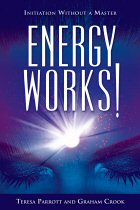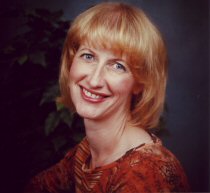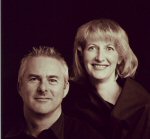

M.B. Ch.B.
M.R.C.P.(UK)
SKHM Teacher
Reiki & Karuna Master

B.M. M.R.C.Psych. MSc.
SKHM Teacher
Reiki & Karuna Master
 |
Patrick
Zeigler Founder of the All Love / SKHM system |
Graham
and Teresa have explored the world of SKHM to a depth that few
have been able to achieve, and, most importantly, they have been
able to share their experience with others through their words
in the most beautiful way. Those who read about their experience
will be initiated in a journey of the heart. I highly recommend
allowing yourself to experience that journey. |
|
Interview with Teresa Parrott and Graham Crook, authors of
‘Energy Works!
Initiation Without a Master’Why did you write the book?
T: Because it needed writing. There are a thousand books about psychiatry, ten thousand books about complementary medicine, and untold millions about self-help. There is only one that we know which combines all three. This is the one.
G: In a nutshell, this is the Do-It-Yourself manual of ‘Out of pain into joy.’
What authority do you have to write this book?T: I’m a qualified psychiatrist, currently working in forensic psychiatry. Both Graham and I are Reiki and Karuna Masters, and SKHM teachers (pronounced Saykem). Graham was a consultant physician in general medicine and chest medicine.
G: It’s interesting how many of us, trained in traditional medicine, are now involved in alternatives. Bernie Siegel is, perhaps, the most famous, but he’s very far from being unique.
Who would want to read this book and who would benefit from it?G: The short answer is anyone – to both questions. We deliberately chose a language which is comprehensible to anybody. Unlike most of the other books out there, you don’t need any inside knowledge to be able to benefit from it. I guess it would be particularly beneficial to anyone working in, or receiving treatment from, any discipline involving “energy” or emotional healing, like Shiatsu, Aromatherapy etc. – also anyone receiving counselling, psychotherapy or treatment for depression. But the short answer remains, anyone in pain.
T: Which is, of course, all of us. We’re all in pain. So much so, we think it’s normal. This is a way out of that pain. It’s also a way out of abnormal pain. As a practising psychiatrist, I deal with that abnormal emotional pain every working day.
The technique described in our book is called SKHM. It was discovered by Patrick Ziegler, who wrote the book’s introduction. When I first came across it, I was sceptical.G: As was I. I think it was natural, having come, like Teresa, from a background of traditional medicine and applied science. Our instincts and training both told us to treat with disdain anything, let’s say, ethereal or – as we would then certainly have called it – airy-fairy.
T: The first thing that struck me, though, between the orthodox technique of my training and Patrick’s more radical one, was not the differences, but the similarities. I think the war of attrition fought between complementary and traditional medicine – at least in my field – is a phoney one. All we’re really doing is emphasising different words in the same sentence.
G: The key word is joy. Once people have felt that energy, they will be experiencing a feeling of joy …
T: And love …
G: You’re right. … joy and love that probably they have never experienced before.
T: And they will find that the experience of that joy will enable them to respond more quickly and with considerably less emotional pain – which of course then enables them far more easily to enter the painful areas that need treating.
How did you come to write it?G: Two things combined. We were writing manuals for teaching. In doing so, we started asking one another questions which none of the text- books were answering. That coincided with my reading a novel Teresa had written. I was knocked out by it. I didn’t realise she had that much talent. I suggested to her that we could put that to good use by writing not just a manual, but a book on SKHM.
T: The novel, by the way, is still looking for a publisher. So, if anyone reading this works for a publishing house …
G: It really is an excellent read.
How did you find the job of co-authoring?
G: (Laughs.) It was a mixture. At its best it was a wonderful way of clarifying our ideas and simplifying them. At its worst, we had to use the “energy” the book talks about not to kill each other. Certainly there were times when I thought we would never finish it.
T: (Also laughing) If we hadn’t already have separated, we would have done.
So, you’re ex-partners writing together. How did that work?T: I think that I just said it. Curiously enough, though – and being serious for a moment – I think it brought us closer together. In a completely different way, of course, to the way we had been when we were living together. In any relationship it’s the pain that holds you apart – the pain of all the things you’ve been unable to express or show your partner about yourself. Working day after day with that energy there was an awful lot of love flowing, and we were able to say things we had been unable to express beforehand.
So, why aren’t you back together?
G: It sounds like a weird way of saying it, but our love now is deeper than that. It’s gone through the sexual barrier. We are now able to hear each other’s emotions and experience them for what they are, rather than for the implications they might involve for us. In other words, we want the best for the other person unequivocally, whatever the consequences to ourselves.
T: And it was the writing of the book that led us to that. We’d be working on a chapter, say about anger or fear, and, lo and behold, we’d both find that we had issues around these subjects which we needed to address. As people, I mean, or as half of a relationship, rather than as authors.
G: And we had to address those issues before we could continue. For ourselves. It’s almost as if we were being tested, as if some divine force were insisting we should be our own guinea pigs.
Would someone who knows nothing about Reiki be able to understand the book?G&T: Yes.
Do you want to qualify that?
G: Not really. Our jumping-off point was that our readers should be able to come to this book without any specialised knowledge.
What distinguishes SKHM as a form of Reiki from any other?
G: SKHM is not actually a form of Reiki. I don’t want to go back on my word here and become too esoteric, but SKHM has gone through a lot of developments. At one stage it was considered by some of its practitioners to be a higher form of Reiki. It would be more accurate to say that both are separate branches off the same trunk.
So, I don’t need to be a scientist to understand it?
G&T: No.
Do you want to qualify that?
G&T: No.
G: You absolutely do not need to be a scientist or a healer or have any knoweldge of medicine or complementary medicine to understand it.
Interview by Greg Dark, author of 'Prophet of the New Millennium'
The Prophet of the New Millennium is not an alternative to Gibran’s book, it is a complement to it. Today’s world is very different to Gibran’s. The political atlas has had to be modified frequently. The Prophet of the New Millennium provides the ethical equivalent.
.
© 2005-2015 Teresa Parrott and Graham Crook. - Copyright
Shenu ©1999-2015 Patrick Zeigler
